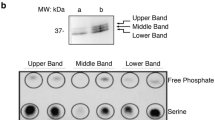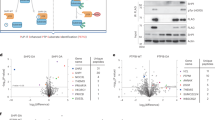Abstract
REGULATION through phosphorylation is a characteristic of signalling pathways1,2, and the lymphocyte kinase Lck (p56 lck) both performs phosphorylation and is affected by it. Lck is a Src-family tyrosine kinase expressed in T lymphocytes, where it participates in the cellular immune response 3. Like all Src homologues, it comprises SH3, SH2 and kinase domains. Lck associates through its distinctive ammo-terminal segment with the cytoplasmic tails of either T-cell co-receptor, CD4 or CD8-α 4,5. Activated Lck phosphorylates T-cell receptor ε-chains, which then recruit the ZAP70 kinase to promote T-cell activation 6. Lck is activated by autophosphorylation at Tyr394 in the activation loop 7 and it is inactive when Tyr 505 near the carboxy terminus is phosphorylated and interacts with its own SH2 domain8. Here we report the crystal structure of the Lck tyrosine kinase domain (LCKK) in its activated state at 1.7 Å resolution. The structure reveals how a phosphoryl group at Tyr 394 generates a competent active site. Comparisons with other kinase structures indicate that tyrosine phophophorylation and ligand binding may in general elicit two distinct hinge-like movements between the kinase subdomains. From modelling studies, we suggest a basis for inhibition by phosphorylation at Tyr 505.
This is a preview of subscription content, access via your institution
Access options
Subscribe to this journal
Receive 51 print issues and online access
$199.00 per year
only $3.90 per issue
Buy this article
- Purchase on Springer Link
- Instant access to full article PDF
Prices may be subject to local taxes which are calculated during checkout
Similar content being viewed by others
References
Fischer, E. H. & Krebs, E. G. J. Biol. Chem. 216, 121–132 (1955).
Johnson, L. N., Noble, M. E. & Owen, D. J. Cell 85, 149–158 (1996).
Perlmutter, R. M. et al. J. Cell. Biochem. 38, 117–126 (1988).
Shaw, A. S. et al. Cell 59, 627–636 (1989).
Turner, J. M. et al. Cell 60, 755–765 (1990).
Iwashima, M., Irving, B. A., van Oers, N. S., Chan, A. C. & Weiss, A. Science 263, 1136–1139 (1994).
Veillette, A. & Fournel, M. Oncogene 5, 1455–1462 (1990).
Veillette, A., Caron, L., Fournel, M. & Pawson, T. Oncogene 7, 971–980 (1992).
Hubbard, S. R., Wei, L., Ellis, L. & Hendrickson, W. A. Nature 372, 746–754 (1994).
Knighton, D. R. et al. Science 253, 407–414 (1991).
Zheng, J. et al. Protein Sci. 2, 1559–1573 (1993).
Mohammadi, M., Schlessinger, J. & Hubbard, S. R. Cell 86, 577–587 (1996).
Russo, A. A., Jeffrey, P. D. & Pavletich, N. P. Nature Struct. Biol. 3, 696–700 (1996).
Sun, H. & Tonks, N. K. Trends Biochem. Sci. 19, 480–485 (1994).
Shoji, S., Titani, K., Demaille, J. G. & Fischer, E. H. J. Biol. Chem. 254, 6211–6214 (1979).
Francis, S. H. & Corbin, J. D. Annu. Rev. Physiol. 56, 237–272 (1994).
Cox, S., Radzio-Andzelm, E. & Taylor, S. S. Curr. Opin. Struct. Biol. 4, 893–901 (1994).
Goldsmith, E. J. & Cobb, M. H. Curr. Opin. Struct. Biol. 4, 833–840 (1994).
Cooper, J. A. & Howell, B. Cell 73, 1051–1054 (1993).
Eck, M. J., Atwell, S. K., Shoelson, S. E. & Harrison, S. C. Nature 368, 764–769 (1994).
Russo, A. A., Jeffrey, P. D., Patten, A. K., Massague, J. & Pavletich, N. P. Nature 382, 325–331 (1996).
Cantley, L. C. et al. Cell 64, 281–302 (1991).
CCP4: A Suite of programs for Protein Crystallography (SERC Collaborative Computing Project no. 4, Daresbury Laboratory, Warrington, 1979).
Brünger, A. T. A System for X–ray Crystallography and NMR (Yale Univ. Press, New Haven, CT, 1992).
Hendrickson, W. A. Science 254, 51–58 (1991).
Jones, T. A., Zou, J.-Y., Cowan, S. W. & Kjeldgaard, N. Acta Crystallogr. A47, 110–119 (1991).
Evans, S. V. J. Mol. Graph. 11, 134–138 (1993).
Nicholls, A., Sharp, K. A. & Honig, B. Proteins 11, 281–296 (1991).
Author information
Authors and Affiliations
Rights and permissions
About this article
Cite this article
Yamaguchi, H., Hendrickson, W. Structural basis for activation of human lymphocyte kinase Lck upon tyrosine phosphorylation. Nature 384, 484–489 (1996). https://doi.org/10.1038/384484a0
Received:
Accepted:
Issue Date:
DOI: https://doi.org/10.1038/384484a0
This article is cited by
-
A Novel Biallelic LCK Variant Resulting in Profound T-Cell Immune Deficiency and Review of the Literature
Journal of Clinical Immunology (2024)
-
The LCK-14-3-3ζ-TRPM8 axis regulates TRPM8 function/assembly and promotes pancreatic cancer malignancy
Cell Death & Disease (2022)
-
Molecular dynamics simulations reveal membrane lipid interactions of the full-length lymphocyte specific kinase (Lck)
Scientific Reports (2022)
-
Regulation of human glioma cell migration, tumor growth, and stemness gene expression using a Lck targeted inhibitor
Oncogene (2019)
-
On the activation and deactivation pathways of the Lck kinase domain: a computational study
Journal of Computer-Aided Molecular Design (2019)
Comments
By submitting a comment you agree to abide by our Terms and Community Guidelines. If you find something abusive or that does not comply with our terms or guidelines please flag it as inappropriate.



